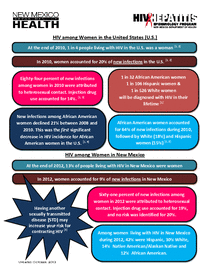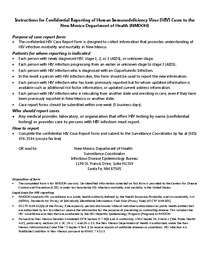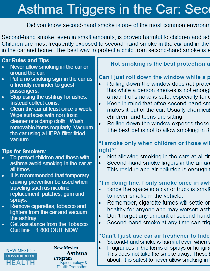Help
 HIV/AIDS Fact Sheet for Women
HIV Surveillance & Epidemiology - Help
November 15, 2013
HIV/AIDS Fact Sheet for Women
HIV Surveillance & Epidemiology - Help
November 15, 2013
This helpful document provides a wealth of helpful facts about HIV/AIDS for Women.
 HIV/AIDS Confidential Case Reporting Form Instructions
HIV Surveillance & Epidemiology - Help
October 9, 2013
HIV/AIDS Confidential Case Reporting Form Instructions
HIV Surveillance & Epidemiology - Help
October 9, 2013
This helpful document explains how to complete the HIV/AIDS confidential case reporting form properly.
 HIV/AIDS Fact Sheet for Hispanics
HIV Surveillance & Epidemiology - Help
October 3, 2013
HIV/AIDS Fact Sheet for Hispanics
HIV Surveillance & Epidemiology - Help
October 3, 2013
This helpful document provides a wealth of helpful facts about HIV/AIDS for Hispanics.
 HIV/AIDS Fact Sheet for African Americans
HIV Surveillance & Epidemiology - Help
October 2, 2013
HIV/AIDS Fact Sheet for African Americans
HIV Surveillance & Epidemiology - Help
October 2, 2013
This helpful document provides a wealth of helpful facts about HIV/AIDS for African Americans.
 Bed Bug Control in Homes
Bed Bugs - Help
August 15, 2013
Bed Bug Control in Homes
Bed Bugs - Help
August 15, 2013
The most effective way to control bed bugs in your home is through a combination of chemical measures and heat treatments applied by a Pest Management Professional (PMP). Unfortunately, the service of a PMP can be costly. So we are providing information on how to control a bed bug infestation on your own.
 Bed Bug Control in Multi-Unit Housing
Bed Bugs - Help
August 15, 2013
Bed Bug Control in Multi-Unit Housing
Bed Bugs - Help
August 15, 2013
There is no silver bullet for eliminating bed bugs. They present a challenge to modern pest control that the industry is still struggling to meet. To make up for the lack of chemical power we have for battling this insect, additional people and tools must be involved. Bed bug success stories usually involve people who live and work in a building (including a pest management professional) coming together as a team to battle this pest.
 Bed Bug Prevention When Moving
Bed Bugs - Help
August 15, 2013
Bed Bug Prevention When Moving
Bed Bugs - Help
August 15, 2013
Once bed bugs have been confirmed in the living area of an individual or family, there may be good reason to move them to a different area or apartment while the infested one is treated. However bed bugs may be transferred with personal belongings, causing more trouble in the new living space.
 Bed Bug FAQ for Property Owners & Managers
Bed Bugs - Help
August 15, 2013
Bed Bug FAQ for Property Owners & Managers
Bed Bugs - Help
August 15, 2013
Bed Bugs are a difficult problem for apartments and multi-family units. It can be very expensive to treat an infested property. However, not addressing the problem will only make the infestation worse and more costly for you. One of the most important things property owners/managers can do is to educate their residents about bed bugs.
 Bed Bug Control in Group Homes & Shelters
Bed Bugs - Help
August 15, 2013
Bed Bug Control in Group Homes & Shelters
Bed Bugs - Help
August 15, 2013
This publication covers bed bug prevention, management and control, education and awareness, and is specifically geared toward public agencies and private or public housing administrators and their facilities management teams. It is applicable to other types of living situations, though techniques and recommendations may need to be adapted.
 Asthma Triggers in the Car Fact Sheet
Asthma - Help
May 6, 2013
Asthma Triggers in the Car Fact Sheet
Asthma - Help
May 6, 2013
Second-hand smoke, even in small amounts, is proven harmful to children and adults. It can bring on an asthma episode. Children are most frequently exposed to second-hand smoke in the car and in the home. A top protection is to eliminate tobacco in the car and home. The best way to protect a child from second-hand smoke is eliminating smoking in the car and home.
 Rabies Manual for Investigation
Zoonotic Diseases - Help
May 1, 2013
Rabies Manual for Investigation
Zoonotic Diseases - Help
May 1, 2013
Provides all the information required to investigate rabies cases including a summary of the disease, agent details, mode of transmission, period of communicability, incubation period, diagnosis, prophylaxis, surveillance, control measures, and more.
 HIV/AIDS Confidential Case Reporting FAQ
HIV Surveillance & Epidemiology - Help
April 12, 2013
HIV/AIDS Confidential Case Reporting FAQ
HIV Surveillance & Epidemiology - Help
April 12, 2013
This helpful document provides answers to frequently asked questions about HIV/AIDS case reporting.
 Notifiable Conditions Reporting FAQ
Occupational Health Surveillance - Help
March 25, 2013
Notifiable Conditions Reporting FAQ
Occupational Health Surveillance - Help
March 25, 2013
Health care providers are the eyes and ears of public health. Reporting makes it possible to detect failures of work place health and safety protection and prevent further illness and injury due to work. This document explains the most frequently asked questions we receive regarding occupational notifiable conditions reporting.
 VFC Refrigerator Setup Guidance
Immunization - Help
March 21, 2013
VFC Refrigerator Setup Guidance
Immunization - Help
March 21, 2013
Before placing vaccines in a new refrigerator unit, follow these simple steps to ensure success.
 Plague Fact Sheet
Zoonotic Diseases - Help
February 7, 2013
Plague Fact Sheet
Zoonotic Diseases - Help
February 7, 2013
This fact sheet explains what the plague is, how people get it, common forms of plague, how to protect yourself, and more.
 Diagnostic Audological Assessment
Children's Medical Services - Help
February 5, 2013
Diagnostic Audological Assessment
Children's Medical Services - Help
February 5, 2013
Audiologist section of the newborn hearing screening program manual.
 Glossary of Newborn Hearing Screening Terms
Children's Medical Services - Help
December 18, 2012
Glossary of Newborn Hearing Screening Terms
Children's Medical Services - Help
December 18, 2012
This glossary of terms makes understanding the terminology used when talking about newborn hearing screening much easier. It explains such terms as auditory brainstem response, audiogram, audiologist, early intervention, and dozens more.
 Physician's Roadmap
Children's Medical Services - Help
December 18, 2012
Physician's Roadmap
Children's Medical Services - Help
December 18, 2012
This form makes it easy for physician’s to track a baby’s hearing screening follow-up tasks from birth to 6 months old.
 Reasons to Follow Up
Children's Medical Services - Help
December 18, 2012
Reasons to Follow Up
Children's Medical Services - Help
December 18, 2012
Explains the many reasons why you should continue with follow-up visits if your baby does not pass newborn hearing screening.
 Birthing Hospital Screening Responsibilities
Children's Medical Services - Help
December 14, 2012
Birthing Hospital Screening Responsibilities
Children's Medical Services - Help
December 14, 2012
Explains requirements for initial hearing screening, rescreening of infants who refer, infants not screened prior to discharge, infants who pass screen but have an identified risk factor, hospital documentation and communication of screening results, hospital screening requirements, and more.


